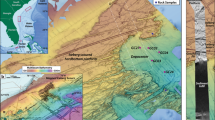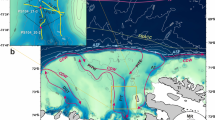Abstract
Deglaciation of North America resulted in the development of the ice-dammed lake Agassiz–Ojibway along the southern margin of the Laurentide Ice Sheet1,2,3,4,5 and its catastrophic northward drainage ∼8.47 kyr ago6. This sudden outburst of fresh water may have weakened the Atlantic ocean overturning circulation and triggered the cold event that occurred 8.2 kyr ago6,7. Geological evidence of this flood has been documented in a red sedimentary bed in cores collected in Hudson Strait6,8 and by submarine features in Hudson Bay9. However, there have been few constraints on the manner in which the lake drained: for example, by flow over the ice sheet or beneath it, in one or several pulses10 and where the flood routes were located5,11. Here we present seafloor images obtained using multibeam sonar, which reveal that the outburst flood displaced icebergs to produce arcuate (arc-shaped) scours on the seafloor with a dominant east-northeast–west-southwest orientation. The flood also produced sandwaves in areas unaffected by the arcuate scours, indicating they were protected from iceberg scouring by overlying ice during the event. We suggest that these sandwaves, along with submarine channels inferred from the data, indicate that Laurentide ice was lifted buoyantly, enabling the flood to traverse southern Hudson Bay under the ice sheet.
This is a preview of subscription content, access via your institution
Access options
Subscribe to this journal
Receive 12 print issues and online access
$259.00 per year
only $21.58 per issue
Buy this article
- Purchase on Springer Link
- Instant access to full article PDF
Prices may be subject to local taxes which are calculated during checkout




Similar content being viewed by others
References
Hardy, L. La déglaciation et les épisodes lacustre et marin sur le versant québécois des basses-terres de la baie de James. Géogr. Phys. Quat. 31, 261–273 (1977).
Teller, J. T. in North America and Adjacent Oceans during the Last Deglaciation Vol. K-3 (eds Ruddiman, W. F. & Wright, H. E. Jr) 39–69 (Geological Society of America, Geology of North America, Boulder, 1987).
Dredge, L. A. & Cowan, W. R. in Quaternary Geology of Canada and Greenland Vol. K-1 (ed. Fulton, R. J.) 214–235 (Geological Survey of Canada, The Geology of North America, Ottawa, 1989).
Veillette, J. J. Evolution and paleohydrology of Glacial Lakes Barlow and Ojibway. Quat. Sci. Rev. 13, 945–971 (1994).
Clarke, G. K. C., Leverington, D. W., Teller, J. T. & Dyke, A. S. Paleohydraulics of the last outburst flood from glacial Lake Agassiz and the 8,200 BP cold event. Quat. Sci. Rev. 23, 389–407 (2004).
Barber, D. C. et al. Forcing of the cold event of 8,200 years ago by catastrophic drainage of Laurentide lakes. Nature 400, 344–348 (1999).
Alley, R. B. et al. Holocene climatic instability: A prominent widespread event 8,200 yr ago. Geology 25, 483–486 (1997).
Kerwin, M. W. A regional stratigraphic isochron (ca. 8,000 14C yr B.P.) from final deglaciation of Hudson Strait. Quat. Res. 46, 89–98 (1996).
Josenhans, H. W. & Zevenhuizen, J. Dynamics of the Laurentide Ice Sheet in Hudson Bay, Canada. Mar. Geol. 92, 1–26 (1990).
Leverington, D. W., Mann, J. D. & Teller, J. T. Changes in the bathymetry and volume of glacial Lake Agassiz between 9200 and 7700 14C yr B.P. Quat. Res. 57, 244–252 (2002).
Clarke, G. K. C., Leverington, D. W., Teller, J. T. & Dyke, A. S. Superlakes, megafloods, and abrupt climate change. Science 301, 922–923 (2003).
Josenhans, H. W. et al. Preliminary seismostratigraphic and geomorphic interpretations of the Quaternary sediments of Hudson Bay. Geol. Surv. Can. Paper 88-1B 271–286 (1988).
Dyke, A. S. in Quaternary Glaciations—Extent and Chronology, Part II: North America (eds Ehlers, J. & Gibbard, P. L.) 373–424 (Elsevier, Amsterdam, 2004).
Teller, J. T., Leverington, D. W. & Mann, J. D. Freshwater outbursts to the oceans from glacial Lake Agassiz and their role in climate change during the last deglaciation. Quat. Sci. Rev. 21, 879–887 (2002).
Clayton, L., Laird, W. M., Klassen, R. W. & Kupsch, W. O. Intersecting minor lineations on Lake Agassiz Plain. J. Geol. 73, 652–656 (1965).
Prinsenberg, J. in Canadian Inland Seas (ed. Martini, I. P.) 187–204 (Elsevier Oceanography Series, Vol. 44, 1986).
Pardee, J. T. Unusual currents in glacial Lake Missoula. Geol. Soc. Am. Bull. 53, 1569–1600 (1942).
Baker, V. R. Paleohydrology and sedimentology of Lake Missoula flooding in eastern Washington. Geol. Soc. Am. Special Paper 144, 79 (1973).
Herget, J. Reconstruction of pleistocene ice-dammed lake outburst floods in the Altai Mountains, Siberia. Geol. Soc. Am. Special Paper 386, 118 (2005).
St-Onge, G. & Lajeunesse, P. in Submarine Mass Movements and Their Consequences (eds Lykousis, V., Sakellariou, D. & Locat, J.) 129–137 (Springer–Kluwer, 2007).
Shilts, W. W. Flow patterns in the central North American ice sheet. Nature 286, 213–218 (1980).
McNeely, R., Dyke, A. S. & Southon, J. R. Canadian marine reservoir ages, preliminary data assessment. Geological Survey Canada, Open File 5049 (2006).
Mulder, T. et al. Marine hyperpycnal flows: Initiation, behavior and related deposits. A review. Mar. Petrol. Geol. 20, 861–882 (2003).
Veillette, J. J. Le rôle d’un courant de glace tardif dans la déglaciation de la Baie James. Géogr. Phys. Quat. 51, 141–161 (1997).
Tweed, F. S. & Russell, A. J. Controls on the formation and sudden drainage of glacier-impounded lakes: implications for jökulhlaup characteristics. Progr. Phys. Geogr. 23, 79–110 (1999).
Thorarinsson, S. The ice-dammed lakes of Iceland, with particular reference to their value as indicators of glacier oscillations. Geogr. Ann. A 21, 216–242 (1939).
Björnsson, H. Subglacial lakes and jökulhlaups in Iceland. Glob. Planet. Change 35, 255–271 (2003).
O Connor, J. E. & Baker, V. R. Magnitudes and implications of peak discharges from Glacial Lake Missoula. Geol. Soc. Am. Bull. 104, 267–279 (1992).
MacAyeal, D. R., Scambos, T. A., Hulbe, C. L. & Fahnestock, M. A. Catastrophic ice-shelf break-up by an ice-shelf-fragment-capsize mechanism. J. Glaciol. 49, 22–36 (2003).
Blott, S. J. & Pye, K. Gradistat: A grain size distribution and statistics package for the analysis of unconsolidated sediments. Earth Surf. Proc. Land. 26, 1237–1248 (2001).
Acknowledgements
We dedicate this paper to the memory of M. Paiement, who contributed to the recovery of the cores presented in this paper, but most importantly a friend who passed away at a too young age. We thank the captain, officers and crew of the CGCS Amundsen 2005 cruise. We also sincerely thank J. E. Hughes Clarke, J. Beaudoin and J. Bartlett (Ocean Mapping Group, University of New Brunswick) for collecting and processing the multibeam data. This study was supported by ArcticNet (Network of Centers of Excellence of Canada), NSERC (Natural Sciences and Engineering Research Council of Canada), the Polar Climate Stability Network and FQRNT (Fonds québécois de la recherche sur la nature et les technologies). A. Huismann, L. Filion (Université Laval) and G. Clarke (University of British Columbia) kindly read earlier versions of the manuscript. This is GEOTOP Publication No. 2008-0012.
Author information
Authors and Affiliations
Corresponding author
Supplementary information
Supplementary Information
Supplementary figures S1-2 and table S1 (PDF 2152 kb)
Rights and permissions
About this article
Cite this article
Lajeunesse, P., St-Onge, G. The subglacial origin of the Lake Agassiz–Ojibway final outburst flood. Nature Geosci 1, 184–188 (2008). https://doi.org/10.1038/ngeo130
Received:
Accepted:
Published:
Issue Date:
DOI: https://doi.org/10.1038/ngeo130
This article is cited by
-
The hyperpycnite problem: comment
Journal of Palaeogeography (2019)
-
Labrador Sea freshening at 8.5 ka BP caused by Hudson Bay Ice Saddle collapse
Nature Communications (2019)
-
A Laurentide outburst flooding event during the last interglacial period
Nature Geoscience (2012)
-
A history of outbursts
Nature Geoscience (2012)
-
A role for icebergs in the 8.2 ka climate event
Climate Dynamics (2010)



